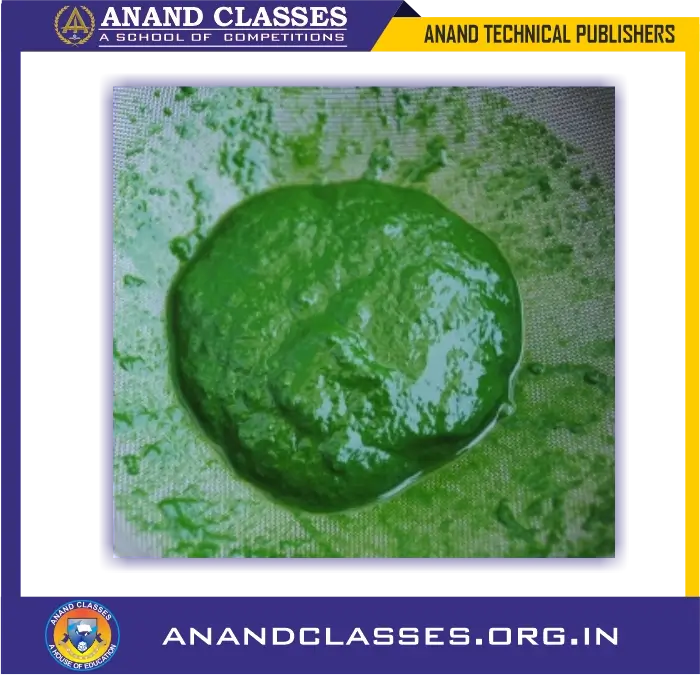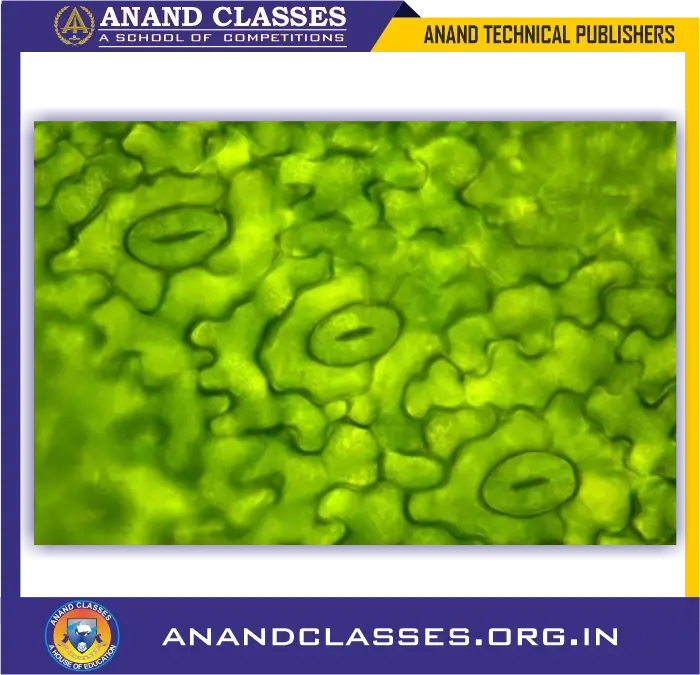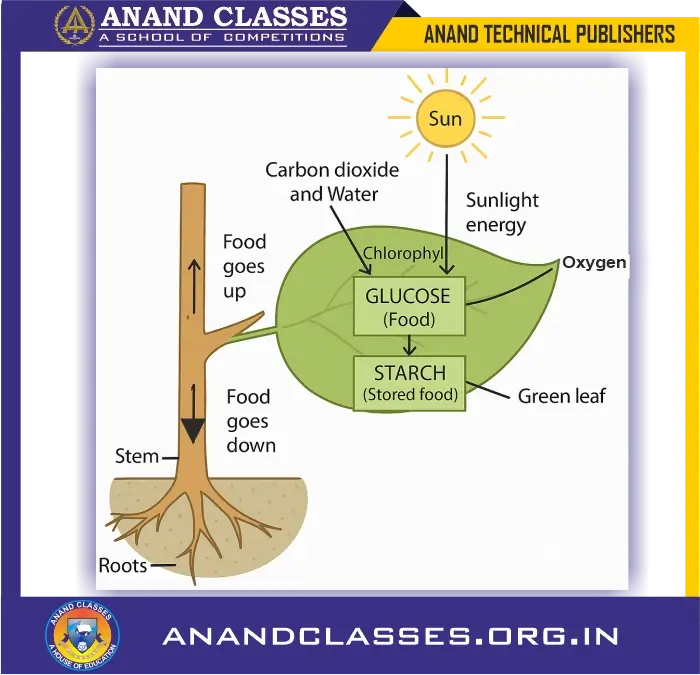ANAND CLASSES Study Material and Notes to learn the process of nutrition in plants, including autotrophic and heterotrophic modes, and explore the mechanism and conditions of photosynthesis essential for Class 10 Science Biology and NEET Foundation.
Nutrition in Plants
Plants, like all living organisms, require food to supply energy for various metabolic activities. Unlike animals, which move in search of food, plants produce their own food through photosynthesis. This ability classifies green plants as autotrophic organisms. The term “photosynthesis” originates from the Greek words “photo” (light) and “synthesis” (to build), meaning “building up by light.”
Process of Photosynthesis
Photosynthesis is the process by which green plants synthesize their food (glucose) from carbon dioxide and water using sunlight energy in the presence of chlorophyll. Oxygen is released as a by-product.
Chemical Equation for Photosynthesis
$$6CO_2 + 6H_2O \xrightarrow{Light \ Energy\: \& \:Chlorophyll} C_6H_{12}O_6 + 6O_2$$
- Reactants: Carbon dioxide (from air), Water (from soil)
- Energy Source: Sunlight
- Catalyst: Chlorophyll (present in chloroplasts of plant cells)
- Products: Glucose (food) and Oxygen (released into the atmosphere)
The process of photosynthesis takes place in the green leaves of a plant. In other words, food is made in the green leaves of the plant. The green leaves of a plant make the food by combining carbon dioxide and water in the presence of sunlight and chlorophyll.
Chlorophyll is present in the green coloured bodies called ‘chloroplasts’ inside the plant cells. In fact, the leaves of a plant are green because they contain tiny green coloured organelles called chloroplasts (which contain chlorophyll).

organelles called chloroplasts inside the
photosynthetic cells of leaves
In the image below a chlorophyll which is extracted from the green leaves of plants.

extracted from the green leaves of plants.
The carbon dioxide gas required for making food is taken by the plant leaves from the air. This carbon dioxide enters the leaves through tiny pores in them called stomata.

Water required for making food is taken from the soil. This water is transported to the leaves from the soil through the roots and stem.
The sunlight provides energy required to carry out the chemical reactions involved in the preparation of food. The green pigment called chlorophyll present in green leaves helps in absorbing energy from sunlight.
Oxygen gas is produced as a by-product during the preparation of food by photosynthesis. This oxygen gas goes into the air.
The food prepared by the green leaves of a plant is in the form of a simple sugar called glucose. This glucose food made in the leaves is then sent to the different parts of the plant. The extra glucose is changed into another food called starch. This starch is stored in the leaves of the plant.

Glucose and starch belong to a category of foods called carbohydrates. The foods like carbohydrates prepared by photosynthesis contain chemical energy stored in them.
Thus, the green plants convert sunlight energy into chemical energy by making carbohydrates (foods). The food prepared by photosynthesis provides all the energy to a plant which it needs to grow. And when we eat plant foods (like foodgrains, fruits and vegetables), the chemical energy stored in them is released in our body during respiration.
Steps of Photosynthesis
- Absorption of sunlight energy by chlorophyll.
- Conversion of light energy into chemical energy, leading to the splitting of water molecules into hydrogen and oxygen.
- Reduction of carbon dioxide using hydrogen to form carbohydrates like glucose.
These steps may not occur simultaneously. Some plants, such as desert plants, absorb carbon dioxide at night and process it in daylight.
Essential Conditions for Photosynthesis
- Sunlight – Provides energy.
- Chlorophyll – Absorbs sunlight.
- Carbon dioxide – Taken in through stomata.
- Water – Absorbed from soil and transported via xylem.
Detailed Mechanism of Photosynthesis
Light-dependent Reactions (Light Reaction)
- Occur in the thylakoid membranes of the chloroplasts.
- Chlorophyll absorbs light energy, exciting electrons.
- Water molecules split into hydrogen, electrons, and oxygen (photolysis).
- Oxygen is released as a by-product.
- ATP (adenosine triphosphate) and NADPH (nicotinamide adenine dinucleotide phosphate) are formed, providing energy for the next stage.
Light-independent Reactions (Dark Reaction or Calvin Cycle)
- Occur in the stroma of chloroplasts.
- Carbon dioxide is fixed using ATP and NADPH to form glucose.
- The cycle involves carbon fixation, reduction, and regeneration of RuBP (Ribulose-1,5-bisphosphate).
FAQs
- Why is photosynthesis important?
- Photosynthesis provides food and oxygen for all living organisms.
- What happens to the glucose formed?
- It is transported to different plant parts and stored as starch.
- Why do desert plants take up CO2 at night?
- To prevent water loss during the daytime.
Conceptual Questions
- How do stomata contribute to photosynthesis?
- Stomata allow the exchange of gases, permitting CO₂ intake and O₂ release.
- What is the role of chlorophyll in photosynthesis?
- Chlorophyll absorbs sunlight and facilitates the conversion of light energy into chemical energy.
- Why is photosynthesis considered an endothermic reaction?
- It absorbs solar energy to drive the synthesis of glucose.
MCQs with Explanations
- Which gas is released during photosynthesis? a) Carbon dioxide
b) Oxygen ✅
c) Nitrogen
d) Hydrogen- Explanation: Oxygen is a by-product of photosynthesis.
- Where does photosynthesis primarily occur in a plant? a) Stem
b) Root
c) Leaves ✅
d) Flowers- Explanation: Leaves contain chloroplasts, which carry out photosynthesis.
Do You Know?
- Leaves appear green because chlorophyll absorbs all colors except green.
- Photosynthesis also occurs in some bacteria and algae.
- Without photosynthesis, the Earth’s oxygen supply would deplete.
- The Amazon Rainforest is often called the “lungs of the Earth” due to its contribution to global oxygen levels.
Worksheet
- Define photosynthesis.
- List the essential conditions for photosynthesis.
- Explain the three main steps of photosynthesis.
- Why are plants called autotrophs?
- What is the role of water in photosynthesis?
- Differentiate between light-dependent and light-independent reactions.
Test Paper (20 Marks)
Section A: (1 mark each)
- What is photosynthesis?
- Name the pigment responsible for photosynthesis.
- What is the primary source of energy for photosynthesis?
- Which plant organelle contains chlorophyll?
- Define stomata.
Section B: (2 marks each)
- Write the chemical equation for photosynthesis.
- Why are plants kept in the dark before photosynthesis experiments?
- How is glucose stored in plants?
- Explain the function of xylem in photosynthesis.
- What is photolysis, and where does it occur?
Section C: (5 marks each)
- Describe an experiment to show that chlorophyll is necessary for photosynthesis.
- Explain the three main steps of photosynthesis with a labeled diagram.
- Describe the role of ATP and NADPH in photosynthesis.
Quick Revision Points
- Photosynthesis: The process by which green plants make food using sunlight, CO₂, and water.
- Reactants: Carbon dioxide, Water.
- Products: Glucose, Oxygen.
- Site: Leaves (chloroplasts).
- Conditions: Sunlight, Chlorophyll, CO₂, Water.
- Light-dependent Reactions: Occur in thylakoids, involve photolysis, ATP, and NADPH formation.
- Light-independent Reactions: Occur in stroma, involve glucose synthesis.
- Importance: Provides food and oxygen for life on Earth.
This structured content ensures a thorough understanding of Nutrition in Plants for competitive exams like NEET, and Class 10 Science Biology CBSE Boards.
🔷 Best Coaching Center for IIT-JEE, NEET, and Foundations
🔹 ANAND CLASSES – The best coaching institute for JEE, NEET, and Class 11-12 Foundations.
🔹 Buy complete study material at 👉 https://publishers.anandclasses.co.in/
🔹 Proprietor: NIRMAL ANAND Educations
🔹 Written by: Neeraj Anand
🔹 Published by: Anand Technical Publishers under Anand Classes
📞 Contact: +91-9463138669
📧 Email: anandclasses1996@gmail.com



